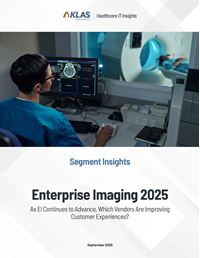 2025 BEST IN KLAS
2025 BEST IN KLAS
Preferences
Related Series
Related Segments


Enterprise Imaging 2022
Which Vendors Are Delivering in a Challenging Environment?
Many healthcare organizations are working to expand and mature their enterprise imaging (EI) strategies to bring together more facilities and service lines. At the same time, both vendors and healthcare organizations are experiencing staffing and budget constraints, leading to a host of financial and operational difficulties. In this environment, some vendors are surmounting challenges and providing the partnership and innovation customers need, while others are struggling to deliver consistently. This report provides an update on vendor performance, based on perspectives from 178 organizations live with EI.
What Is Enterprise Imaging?
KLAS defines enterprise imaging as the ability to store and/or view images across the enterprise in one place from more than one service line and/or from multiple PACS or long-term storage solutions. Data in this report comes only from organizations leveraging their VNA and/or UV for enterprise imaging.
Agfa HealthCare & Merative (IBM) Have Improved Relationships; Ongoing Challenges Remain
Customer satisfaction with most EI vendors has dropped over the last year. Agfa HealthCare and Merative (Merge)—who have some of the largest and most complex customers—are no exception, yet customers report the vendors have made efforts to smooth relationships amid a difficult year. Agfa customers appreciate the vendor’s increased executive involvement and engagement and their strong technology offerings. Some ongoing challenges with support expertise and timeliness have led to an overall score decrease. Merative customers (acquired from IBM) report a largely consistent support experience, and they speak highly of the vendor’s smoothly integrated product suite. Perception of slow development and some UV performance issues have driven score drops. Customer satisfaction with GE Healthcare, particularly regarding relationships, is highly variable and much higher among smaller organizations (<500 beds). Across organization sizes, satisfaction is higher with the vendor’s VNA than UV. Mach7 Technologies’ UV customers (whose use is primarily referential) remain largely satisfied; for VNA customers, support and upgrade challenges have led to a sharp decline in satisfaction.
Fujifilm Maintains Strong Satisfaction while Performance Drops for Most VNA Solutions
Fujifilm, Hyland, and Philips have widely adopted VNAs; their KLAS-validated UV adoption is more limited. In a year where most VNAs saw performance decreases, Fujifilm is providing a largely consistent customer experience. Fujifilm VNA customers of all sizes report the VNA is truly neutral in handling image types and appreciate Fujifilm’s engagement and strong support. Some feel the vendor’s road map is unclear. The limited number of interviewed UV customers are likewise largely satisfied. Hyland VNA customers—among the largest in this study—struggle with mixed support experiences and an unclear development road map. UV customers are notably smaller than VNA customers and are more satisfied. Philips’ EI customers (acquired from Carestream) tend to be fairly small, and all interviewed also use the acquired Carestream PACS. Customers appreciate the ability to store and view multiple image types. They note that Philips has strong resources but that support and implementation quality is inconsistent.
Vendors with limited EI validations
Visage Imaging’s UV—used primarily diagnostically within radiology—continues to deliver strong performance. The limited number of interviewed Change Healthcare and Sectra VNA customers report high satisfaction. Satisfaction with InsiteOne’s VNA is split between large and small organizations; the latter are more satisfied. These vendors’ offerings are covered more fully in the following pages, which focus specifically on VNAs and then UVs.

Vendor Neutral Archives
Fujifilm Continues to Lead in Satisfaction; Change Healthcare & Sectra (Limited Data) Deliver Strong Relationships to Smaller Customer Bases

Fujifilm continues to deliver strong relationships and technology to their VNA customers, who appreciate the solution’s stability, flexibility, and ease of administration. Fujifilm offers strong support when issues arise. While the vendor provides some strategic engagement, a number of customers feel Fujifilm has an unclear road map and doesn’t actively try to understand customer goals. Philips’ VNA (Carestream) continues to be stable for smaller customers and meets their needs. However, inconsistent support, a number of poor implementations and upgrades, and slow development have resulted in an almost 9-point satisfaction drop. Satisfaction among Merative (Merge) customers has remained mostly steady. Customers find the solution easy to use and able to run in the background as needed. Support has been consistent, though with some reports of after-hours struggles. Some respondents feel development has been stagnant and are looking to Merative to turn things around. Agfa HealthCare customers say the vendor understands EI and offers a reliable, flexible, easy-to-use VNA. Respondents note Agfa has worked to stabilize relationships by improving processes and getting new hires up to speed. Support can be hit or miss since some on-the-ground resources still lack needed technical expertise.
Sectra and Change Healthcare deliver well to their smaller customer bases. Sectra’s VNA is sold only to Sectra PACS customers. The limited number of KLAS-validated EI customers report high satisfaction, noting the VNA’s reliability and Sectra’s close partnerships. All seven Change Healthcare VNA customers interviewed also use Change Healthcare’s PACS. They report high satisfaction with the VNA, which they describe as functional, easy to use, and well integrated; some feel the technology is still early. Respondents appreciate the vendor’s customer-focused resources and are hopeful the vendor will deliver on their road map for the cloud.
GE Healthcare’s Delivery Varies Widely by Customer Size; Support and Delivery Challenges Drive Score Drops for Hyland & Mach7
Most interviewed GE Healthcare customers agree the VNA is easy to use and maintain. Overall, satisfaction is polarized—smaller organizations (<500 beds) are generally satisfied with the VNA’s stability and the vendor’s level of service. Larger organizations more frequently report dissatisfaction—particularly when it comes to resource expertise.
The Hyland VNA supports many service lines and image types, though customers note it can be complex and difficult to administer. Respondents feel less connected to Hyland due to support difficulties, lagging development, and inadequate training. Mach7 Technologies’ VNA does what is needed but is sometimes harder to use than others in the market. In contrast to the vendor’s support for the UV, support for the VNA has declined. Customers cite issues with communication, timeliness, and access to individuals who can solve problems. A handful of customers have also experienced poor upgrades and feel development is lacking.
InsiteOne offers a cloud-based VNA (reacquired from NTT DATA in 2021). Satisfaction is split—all three interviewed small customers are satisfied and say the VNA works as needed. The three interviewed large customers are planning to leave, pointing to instability, lack of innovation, and poor proactivity from the vendor.

Universal Viewers
Visage Imaging Gains Energy with Strong Diagnostic Viewer; Mach7 Technologies Delivers for Referential Viewing
Over the past year, customer satisfaction with Visage Imaging, Mach7 Technologies, and Philips remained steady, while satisfaction with other vendors (see next section) notably declined. Visage Imaging’s diagnostic viewer has seen quick growth in recent years and has been validated to span the enterprise and work with other archiving systems. Adoption remains primarily within radiology. Customers appreciate the UV’s speed, ease of use, and advanced functionality, as well as Visage Imaging’s partnership. Half of interviewed customers mention the vendor is experiencing growing pains while newly hired resources get up to speed.
Mach7 Technologies’ acquired UV is used primarily for referential viewing, and customers are much more satisfied with it than the VNA. Respondents appreciate receiving consistent support since the acquisition and highlight the solution’s stability, ease of use, and light footprint. Their core complaint is that the viewer’s diagnostic capabilities are notably weaker than its referential ones. The Philips UV (Carestream) provides a largely consistent experience, and respondents find it easy to use. Most validated integrations are with other Philips products (namely the VNA). A number of customers leverage the UV for diagnostic viewing, though the lack of more advanced functionality means it is still mostly used for referential viewing. Respondents note Philips’ support personnel are able to solve problems but can be slow.
Fujifilm’s UV was validated in six organizations, all of whom are satisfied with their experience; they cite strong support, easy-to-use technology, and the ability to connect to multiple service lines. Customers commonly request more administrative configurability and training.

Unkept Promises Lead to Dissatisfaction with GE Healthcare; Merative & Agfa HealthCare Provide Functional UVs with Inconsistent Delivery
Customer satisfaction for GE Healthcare’s UV has sharply decreased in the last year. Inconsistent ongoing support and persistent nickel-and-diming are common across customers of all sizes. Respondents—especially larger organizations—report unkept promises regarding functionality and upgrades. Compared to most other UVs, GE Healthcare’s is more frequently used for diagnostic reading, which some organizations have successfully leveraged across multiple service lines.
Merative’s UV (Merge) facilitates integration and is seen as easy to use, and it is leveraged for both referential and diagnostic viewing. Support experiences are less consistent for UV customers than VNA customers—while some UV customers have seen improvements in the last year, others report decreased engagement. Slow perceived innovation, frequent nickel-and-diming, and performance issues have decreased satisfaction for a handful of customers. Agfa HealthCare UV customers note the vendor has improved in listening to and working with customers. The UV is seen as lightweight, easy to deploy, and flexible. Respondents use it primarily for referential viewing; KLAS has also validated some large organizations using it diagnostically in multiple service lines. Nickel-and-diming and difficulty connecting with support have detracted from the overall customer experience. Hyland customers generally find the UV to be easy to integrate and able to meet their needs for referential and diagnostic viewing; a number of respondents want more advanced functionality. Customers have difficulty connecting to helpful resources, experience bumpy implementations, and lack a clear road map for innovation—leading to a decrease in satisfaction over the last year.


About This Report
Each year, KLAS interviews thousands of healthcare professionals about the IT products and services their organizations use. These interviews are conducted using a standard quantitative evaluation, and the scores and commentary collected are shared online in real time so that other providers and IT professionals can benefit from their peers’ experiences. To enable readers to more quickly understand high-level differences in vendor performance and give better context as to how each product compares to other offerings in the market, KLAS has organized the questions from the standard evaluation into six customer experience pillars—culture, loyalty, operations, product, relationship, and value.

Sample Sizes
Unless otherwise noted, sample sizes displayed throughout this report (e.g., n=16) represent the total number of unique customer organizations interviewed for a given vendor or solution. However, it should be noted that to allow for the representation of differing perspectives within any one customer organization, samples may include surveys from different individuals at the same organization. The table below shows the total number of unique organizations interviewed for each vendor or solution as well as the total number of individual respondents.
Some respondents choose not to answer particular questions, meaning the sample size for any given vendor or solution can change from question to question. When the number of unique organization responses for a particular question is less than 15, the score for that question is marked with an asterisk (*) or otherwise designated as “limited data.” If the sample size is less than 6, no score is shown. Note that when a vendor has a low number of reporting sites, the possibility exists for KLAS scores to change significantly as new surveys are collected.


Writer
Elizabeth Pew

Designer
Madison Moniz

Project Manager
Jill Wilcock
This material is copyrighted. Any organization gaining unauthorized access to this report will be liable to compensate KLAS for the full retail price. Please see the KLAS DATA USE POLICY for information regarding use of this report. © 2025 KLAS Research, LLC. All Rights Reserved. NOTE: Performance scores may change significantly when including newly interviewed provider organizations, especially when added to a smaller sample size like in emerging markets with a small number of live clients. The findings presented are not meant to be conclusive data for an entire client base.













